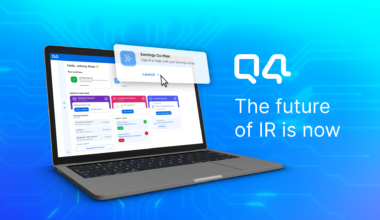Investor relations (IR) have changed dramatically over the past few years, with social media playing an increasingly important role. While traditional communication channels, like press releases and quarterly reports, remain important, integrating social media into your IR strategy can amplify a company’s message and provide platforms for communication for audiences they otherwise wouldn’t reach.
As an IR professional, you must give yourself every opportunity to reach the right investors. However, pursuing that audience can be a struggle if you limit yourself to just the traditional channels IR has used in the past. By properly leveraging social media platforms and tailoring your messages based on the demographics and functionalities available, you can engage with entire sectors of potential investors you wouldn’t normally interact with.
In this article, we explore:
- The importance of social media in IR
- Best practices for using social media for IR communications
- Identify the six benefits of using social media for IR
Social media rules of the road
Social media platforms provide additional channels for distributing content and can help increase IR efforts’ impact and reach more investors.
Here are five best practices to gain more visibility and stand out:
- Develop a distinct social media identity for IR, separate from the corporate profile, focusing on product and customer service. Keeping these pages separate helps ensure that content is relevant for followers of each page and makes it easy for specific audiences to find what they want.
- Leverage hashtags and tagging to help posts appear in the right feeds. Ensure you are directing your social audiences to relevant conversations while monitoring what people say about the brand, detect patterns in sentiment, and react quickly when necessary.
- Use social channels to showcase news and updates, drive event attendance, reference execution against key objectives, and metrics for engagement with press releases and other relevant information.
- Leverage graphics, video, and other media to emphasize key updates and achievements and facilitate engagement. Get creative and try experimenting with multiple media to see which type of content resonates most and distinguishes you from your peers.
- Ensure your social content is in sync with your company’s brand guidelines and aligns with your target audiences, messaging, and overall tone.
Investor relations social media optimization
Social media can also be instrumental in delivering key results your company has achieved and helping mitigate risks to your company’s reputation.
One example of mitigating risks includes responding to social media comments as quickly as possible. You must control the message by responding promptly before any other weigh-in. It’s also valuable for time-sensitive responses to real-time events and engaging investors during a potential crisis.
This level of public transparency and engagement can help to build trust. Providing another channel for potential investors to see and engage with your company also increases the likelihood of finding the right investors, but it’s essential to approach these channels strategically. Specifically, you need to ensure you follow these best practices when delivering IR-relevant content:
- Develop a distinct social media identity for IR, separate from the corporate profile, focusing on product and customer service. Keeping these pages separate helps ensure that content is relevant for followers of each page and makes it easy for analysts and investors to find what they want.
- Define your policy, process, and goals to meet disclosure rules, designate appropriate and effective social media spokespeople, and establish a clear-cut strategy for approving content before publication.
- Establish key performance indicators (KPIs) for measuring success, including increasing visibility, transparency, and brand awareness.
- Craft your content strategy, closely considering which social platforms are the best fit for achieving your IR goals.
- Work to create compelling, concise content, coordinating social posts with scheduled press releases, earnings calls, and investor conferences. Make references to the key metrics and information of most interest to investors.
- Try to include quotes from and link back to press releases, earnings call scripts, and other previously disclosed information.
Understanding the value of different social channels
X, formerly known as Twitter
Every social channel serves a different purpose, and the style of your content should reflect that. For instance, although there have been many recent changes with X, formerly known as Twitter, it still has some significant benefits. One advantage is that there is a sizeable financial community on X that use the #Fintwit hashtag. Many investors rely on posts to feeds like this for updates on financial news and trends.
Especially if you’re seeking a younger audience with a high degree of tech-savviness, X trends are both younger and more tech-proficient than other social media. Your team can also proactively post as a part of the actual earnings cadence. This can encourage engagement with your company’s story around your earnings event and provide timely updates.
It has to be noted that X is in a highly volatile condition. With many news media sources reporting on the potential for misinformation and “fake news” on X, it’s essential to keep up to date on X’s development in the future.
Another popular platform for sharing IR messaging is LinkedIn. As the world’s largest professional network, it is one of the best-suited social platforms for IR, with over 930 million users and more than 61 million companies on the LinkedIn platform.
With a large, professional user base, LinkedIn is best leveraged for sharing corporate content such as slide presentations, blog posts, thought leadership, and market updates. In addition, analysts are most likely to review LinkedIn as one of their first or second engagements.
In its infancy, Facebook was predominantly a personal platform, with only a few corporations exploring its capabilities. Over time, Facebook began to gain mainstream acceptance in the IR community and was leveraged for its tools for targeted engagement, live video content, and efficient crisis communication.
Then, post-2020, the social media landscape shifted again. With the rise of multiple communication platforms and growing concerns about data privacy and misinformation, IR strategies diversified, reflecting the vast opportunities and inherent challenges of using Facebook for IR efforts.
Currently, some of the best ways to leverage Facebook are to gauge public sentiment, analyze the audiences’ reactions to posts, and even correlations to stock movements. Regarding demographic and audience analysis, few social media companies can give you access to the level of insights Facebook provides
Other social media channels for IR
- YouTube has been among the top domestic and global web traffic destinations for years, with over 2.7 billion active users. With over half of those users using YouTube from a mobile device, having a presence providing video content significantly increases investor engagement.
- Instagram is also worth mentioning as it is an excellent way to visually connect with a more modern audience.
- Tools such as Sprout Social can help monitor activity across platforms, and most have built-in page analytics offering insights that can highlight which content is performing well to inform your ongoing strategy.
- Mastodon, often described as similar to X, has significantly grown its subscriber base over the last few months.
- Another popular video clip social media platform is TikTok, which constantly evolves its offerings.
Last words on Social media IR engagement
Outside of managing your company’s social media, you need to observe the social media accounts of your competitors. This can be a low-cost and easy way to learn how they engage investors, gauge their shareholder reactions, and gain insights on what may be on the horizon for your industry and your company.
Social media’s ability to help IROs expand the reach of their efforts, open an additional channel for investors to connect with the company, and gain insight into competitors is undeniable. With a LinkedIn study indicating investors are more likely to consult digital media (63%) than finance-specific trade publications (48%), building a strong presence across all digital channels is critical to reaching investors.
As the world of investor relations continues to evolve, ensuring a robust and strategic presence on social media is essential. Whether you’re an established enterprise or a burgeoning startup, harnessing the power of these platforms can significantly enhance your IR efforts.
So, as an IR professional, using social media to communicate your message benefits your company with:
- Enhanced Reach: Connect with a broader and more diverse audience, including younger and international investors.
- Real-time Communication: Quickly spread news and updates and respond to inquiries.
- Crisis Management: Proactively address concerns and control narratives during potential crises, upholding investor trust.
- Cost-effective Engagement: Interact with a large audience at a relatively lower cost than traditional IR events.
- Brand Building: Establish and maintain a consistent corporate narrative, reinforcing the company’s values and mission.
- Competitor Monitoring: Keep an eye on competitors’ communications and investor sentiments to stay ahead of industry trends.
For more insight into how social media is changing investor relations, read Meme stocks: How social media broke the stock market, and to see more thought leadership on all topics in IR, see the Q4 blog.


